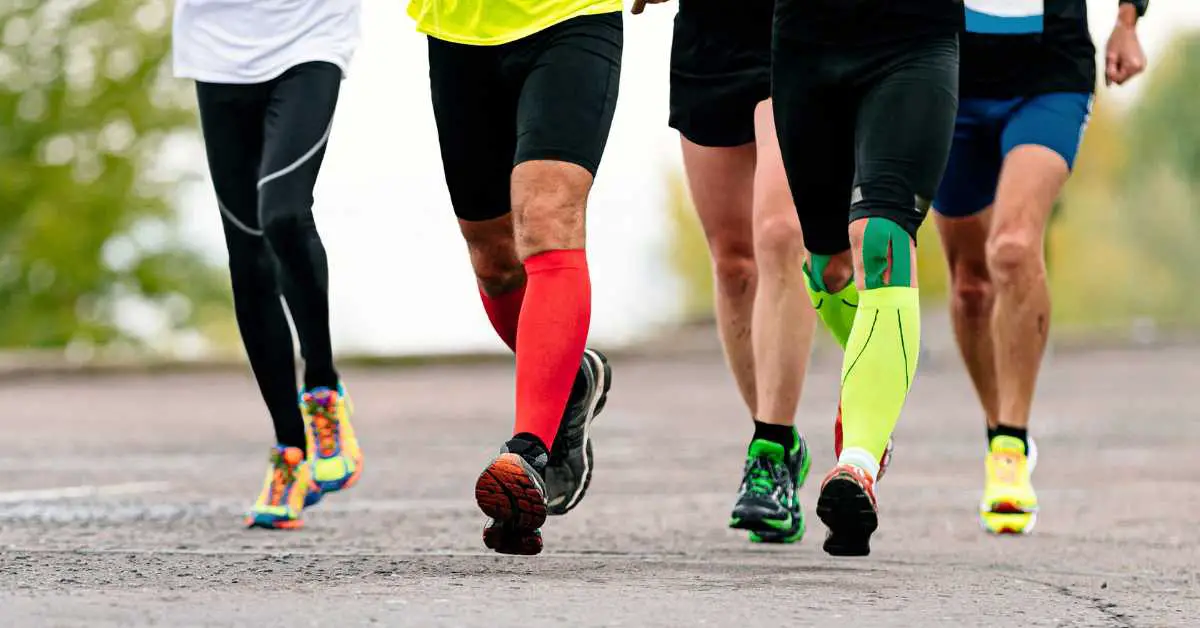If you’re someone who’s active or spends a lot of time on their feet, you’ve probably heard about the benefits of compression wear. These garments are designed to improve blood flow and reduce muscle fatigue, making them popular among athletes and those with certain medical conditions.
But with so many different types of compression wear on the market, it can be hard to know which one is right for you. In this article, we’ll be focusing on two of the most popular options: compression socks versus compression sleeves.
While both types of garments serve similar purposes, there are some key differences between the two that are important to consider. Whether you’re looking to improve your athletic performance or alleviate symptoms of a medical condition, understanding these differences can help you make an informed decision about which type of compression wear is best suited to your needs.
So let’s dive in and take a closer look at the world of compression wear!
Contents
How do compression socks work?
Compression socks are specialized garments that are designed to fit tightly around the feet, ankles, and calves, exerting pressure on the underlying tissues. This pressure helps to improve blood flow by squeezing the veins and pushing blood back toward the heart.
They are often used by athletes, travelers, and people who spend long periods of time standing or sitting. Compression socks can also be helpful for individuals with certain medical conditions, such as varicose veins, lymphedema, and deep vein thrombosis.
Athletes use compression socks during intense training and competition to improve their performance and recovery time. The increased blood flow can help to deliver oxygen and nutrients to the muscles, while also reducing the build-up of lactic acid and other waste products.
For travelers, compression socks can help to prevent the development of deep vein thrombosis, a potentially life-threatening condition that can occur when blood clots form in leg veins. These socks are often called varicose vein socks.
Some of the best compression socks on the market are Copper Fit compression socks and TED hose stockings by Doc Miller.
How to put on compression socks
Putting on compression socks can be a little tricky at first, but with a bit of practice, it will become second nature. Here’s a step-by-step guide to help you get started:
Start by purchasing the right size and level of compression for your needs. Compression socks come in different sizes and levels of pressure, so be sure to consult with your doctor or a trained medical professional to determine the best option if you are buying them for health concerns.
- Roll the top of the sock down so that the heel is inside out.
- While sitting, place your foot into the sock, making sure that the heel is in the right position.
- Begin to gently pull the sock up, making sure that it’s snug but not too tight. If you feel any discomfort or pain, stop and adjust the sock as needed.
- Continue pulling the sock up, making sure that there are no wrinkles or bunches of fabric. If you need to, use your fingers to smooth out any wrinkles and to make sure the sock is properly aligned.
- Once the sock is on, move your foot around to make sure that it’s not too tight around the toes, heel, or ankle. You should be able to wiggle your toes and move your ankle freely.
- Repeat the process with the other sock.
How long should you were compression socks for shin splits?
The length of time you should wear compression socks for shin splints may vary depending on the severity of your condition and your individual needs. In general, it’s recommended to wear compression socks for shin splints during activity and for a period of time after activity to aid in recovery.
For moderate to severe cases of shin splints, it’s recommended to wear compression socks during all waking hours until symptoms improve. This may include wearing them for several days or weeks until pain and inflammation subside.
For mild cases of shin splints, compression socks may be worn during activity and for a period of time after activity to aid in recovery. This may include wearing them for a few hours each day until symptoms improve.
It’s important to consult with your doctor or a trained medical professional to determine the appropriate length of time to wear compression socks for shin splints based on your individual needs and condition.
You may also be interested in the best compression socks for standing all day.
How do compression sleeves work?
Compression sleeves are tight-fitting garments that apply pressure to muscles and tissues. They are different from compression socks, which cover the entire leg because they are intended to target a specific area of the body (like the knee or elbow). Think of them as toeless compression socks.
Compression sleeves work by compressing veins and encouraging blood flow back to the heart, reducing the accumulation of waste products that contribute to muscle soreness and fatigue.
Additionally, they provide support and stability to muscles and joints, which is beneficial for athletes and individuals with certain medical conditions. Compression sleeves come in various sizes and compression levels suited to individual needs.
How to wear calf compression sleeves
Here are the steps to follow when wearing a calf compression sleeve:
- Start by selecting the correct size and compression level for your needs. Make sure to read the manufacturer’s instructions and consult with a medical professional if necessary.
- Begin by turning the calf compression sleeve inside out so that the rubber grips are facing outward.
- Carefully slide the sleeve up your leg, starting at the ankle and working your way up to the calf. Make sure that the sleeve is evenly positioned and not twisted or bunched up.
- Once the sleeve is in place, gently adjust it to ensure a comfortable fit. The compression should feel snug but not too tight, and there should be no areas where the sleeve is digging into your skin.
- If you’re wearing the calf compression sleeve during exercise, make sure to warm up first and gradually increase the intensity of your workout. Remember to stay hydrated and listen to your body for any signs of discomfort or pain.
- When you’re finished using the calf compression sleeve, carefully remove it by pulling it down from the top of your calf.
- Make sure to properly care for your calf compression sleeves by washing them according to the manufacturer’s instructions and storing them in a cool, dry place.
How long should you wear a compression sleeve for lymphedema?
The length of time you should wear a compression sleeve for lymphedema may depend on the severity of your condition and the advice of your doctor. In general, compression sleeves for lymphedema are typically worn during waking hours, and may be removed at night or when bathing or swimming.
It’s important to wear your compression sleeve consistently to achieve the best results. For many people, this may mean wearing the sleeve for several hours each day, or even all day, depending on the severity of their condition.
In some cases, your doctor may recommend wearing lymphedema stockings for a longer period of time, or even indefinitely, to help manage your symptoms and prevent further complications.
It’s important to work closely with your doctor or a trained medical professional to determine the appropriate length of time to wear a compression sleeve for lymphedema based on your individual needs and condition.
How to know which is best for you?
When deciding between compression socks vs compression sleeves, there are a few factors to consider:
Area of coverage: Compression socks cover the entire foot and calf, while compression sleeves are designed to target a specific area of the body, such as the calf or knee. If you’re experiencing swelling or pain in your feet or ankles, compression socks may be a better choice. If you’re experiencing swelling or pain in a specific area of your leg, such as your calf, a compression sleeve may be more appropriate.
Compression level: Compression socks and sleeves come in a variety of compression levels, ranging from mild to intense. The level of compression you need may depend on the severity of your symptoms and your individual needs. Compression socks typically provide more overall compression than sleeves, which may make them a better choice for individuals with more severe symptoms.
Activity level: Compression socks and sleeves can both be worn during exercise or other physical activity to help improve blood flow and reduce muscle fatigue. However, compression sleeves may provide more freedom of movement and flexibility, making them a better choice for athletes or individuals who need to move around more during their activities.
FAQs
What is the difference between compression socks and compression sleeves?
Compression socks cover the entire foot, ankle, and lower leg, while compression sleeves only cover the calf, leaving the foot exposed. Socks provide full coverage and help with circulation from the foot upward, while sleeves focus on muscle support and reducing leg fatigue.
Which is better for swelling and circulation issues?
Compression socks are the better choice for swelling (edema) and circulation issues like varicose veins or deep vein thrombosis (DVT) because they provide graduated pressure from the foot upward. Compression sleeves do not cover the foot, so they don’t help prevent swelling in the ankles.
Are compression sleeves or socks better for running and sports?
Compression sleeves are popular among runners and athletes because they support the calf muscles, reduce fatigue, and improve recovery without restricting foot movement. However, compression socks may be better for long-distance runners or athletes who experience foot swelling.
Can I wear compression socks or sleeves all day?
Compression socks can be worn all day if needed, especially for travel, work, or medical conditions. Compression sleeves are best worn during activity and should be removed when resting unless otherwise recommended by a doctor.
How do I choose the right compression level?
Compression levels are measured in mmHg (millimeters of mercury). For general use and sports recovery, 15-20 mmHg is common. For medical conditions like varicose veins or DVT, 20-30 mmHg is recommended. Always consult a doctor if you need higher compression levels.
Summary
Compression socks and sleeves are both designed to improve blood flow and reduce muscle fatigue, but they target different areas of the body. Compression socks cover the foot and calf, while compression sleeves are designed for a specific area, such as the calf or knee. Choosing the best option for you depends on the area of concern, the level of compression needed, your activity level, as well as personal preference.

Rick Huey is a fitness writer who has dedicated his life to living an active lifestyle. With more than 30 years of experience in the fitness industry, Rick is a respected contributor for FitFab50.com, where he shares his wealth of knowledge with a wide audience. His dedication to promoting the benefits of living an active lifestyle has inspired many people to pursue their own fitness journeys with enthusiasm and dedication.
